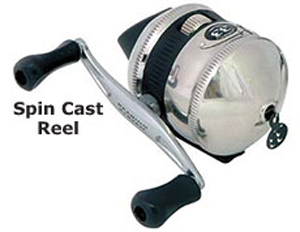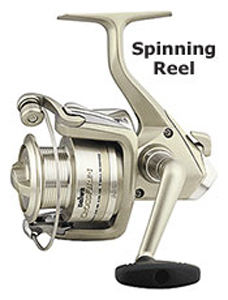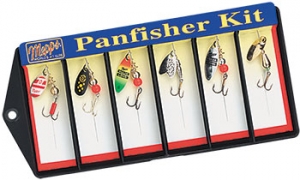by Jim Martinsen
Many anglers find today's wide variety of fishing tackle more than just a little confusing. What reel goes with what rod? What lure goes with what line? Should a swivel be used? How heavy a line should I use for bass fishing? What about trout fishing? Do I need ultra lite equipment to catch panfish? The questions are endless.
The answers, fortunately, come easily. Sport fishing is not complicated. Most people still fish to have fun. The fun in fishing is putting a bend in the rod, and you don't need to spend a fortune to do this. To begin with, every successful fisherman should pay attention to the information printed on the manufacturer's packaging.
Let's assume you're in the market for that "general purpose, all-round" fishing rod; the one that "just feels right" when you pick it up. If you're looking for a rod like this, you probably do not have a solid walnut rod rack in your den that sports a dozen or so custom-built rods. What you probably have is a very functional spin cast rod in your garage that you're ready to pass on to a youngster, because you're ready for an upgrade.

Spinning or Spin-cast? - Chances are you'll be considering either a spinning or spin-cast rod and reel. Some manufactures offer prepackaged rods and reels. But if you're buying these items separately, you'll need to know what to look for. A spinning rod has a straight handle with no finger hook (see illustration), while a spin cast rod has a handle that is tipped down slightly, and there is a finger hook on the bottom. This is to wrap your index finger around when you cast. Also, a spin-cast reel sets on top of the rod while a spinning reel hangs below the rod. Spinning reels do not work well with spin cast rods and vice versa. So, make sure your rod and reel match.


Rod Selection - Whether you buy a spin cast or spinning rod, choose a rod five and one-half to six feet long that will handle lures weighing between 1/12 and 1/3 ounce. This is a medium-light to medium rod. Most rod manufacturers print this information on the butt of the rod where it attaches to the handle. Make sure the reel you buy has been built to the same tolerances. Now you're ready to fish for panfish, bass, walleye, catfish or just about any other fresh water fish that you're liable to catch short of a giant pike or musky.
Reel Selection - Most novice anglers find spin cast reels are easier to use than spinning reels. They may not hold as much line or cast as far as a spinning reel, but if you plan to fish two or three times a summer, or if you're buying a rod and reel for a youngster, you really can't go wrong if you buy a brand name spin cast outfit.
 Spinning reels hold more line and will cast farther than a spin cast outfit. However, you do have to hold onto the line with your index finger to cast (on most models) and a few folks have trouble with this. Spinning rods are also excellent for slip bobber fishing. If you don't know what slip bobber fishing is you probably do not need a spinning rod.
Spinning reels hold more line and will cast farther than a spin cast outfit. However, you do have to hold onto the line with your index finger to cast (on most models) and a few folks have trouble with this. Spinning rods are also excellent for slip bobber fishing. If you don't know what slip bobber fishing is you probably do not need a spinning rod.
 Setting Your Reel's Drag - It's difficult to imagine how many fish are lost every year just because the drag on the reel has been set improperly. The drag acts as the reel's clutch, much the same way that a clutch works on a car. Many spinning and spin-cast reels have a numbering system that lets the fisherman know at a glance where his drag is set. Usually, the lower the number the lighter the drag. Under normal fishing conditions you would never tighten the drag down all the way. The best method of setting drag is to run your line through the rod so you have about four feet hanging from the tip. Grab the end of the line and gently pull down. This forces the rod tip to bend. Keep your eye on the bend in the rod. If you feel the rod tip is becoming too stressed, lighten the drag until line strips freely from the reel. If line begins to strip from the spool as soon as the rod tip begins to bend, tighten the drag slightly. By following this procedure you will soon establish the proper drag setting for every rod and reel you own. Go through this procedure anytime you suspect your drag may be set improperly, and especially after you've readjusted the drag while fighting a big fish. If you don't, you'll soon find yourself purchasing an awful lot of lures.
Setting Your Reel's Drag - It's difficult to imagine how many fish are lost every year just because the drag on the reel has been set improperly. The drag acts as the reel's clutch, much the same way that a clutch works on a car. Many spinning and spin-cast reels have a numbering system that lets the fisherman know at a glance where his drag is set. Usually, the lower the number the lighter the drag. Under normal fishing conditions you would never tighten the drag down all the way. The best method of setting drag is to run your line through the rod so you have about four feet hanging from the tip. Grab the end of the line and gently pull down. This forces the rod tip to bend. Keep your eye on the bend in the rod. If you feel the rod tip is becoming too stressed, lighten the drag until line strips freely from the reel. If line begins to strip from the spool as soon as the rod tip begins to bend, tighten the drag slightly. By following this procedure you will soon establish the proper drag setting for every rod and reel you own. Go through this procedure anytime you suspect your drag may be set improperly, and especially after you've readjusted the drag while fighting a big fish. If you don't, you'll soon find yourself purchasing an awful lot of lures.
"Fish don't break tackle, fishermen break tackle." Attach a heavy duty reel spooled with 20-pound-test line to a light action rod and the first time you set the hook the rod will break. Attach a light duty reel to a heavy duty rod and the first time you set the hook the drive gear on the reel will strip. This is not the fault of the equipment, this is the fault of the fisherman.
Line Selection - Okay, you've selected your medium light to medium rod and reel combo. Now you must turn your attention to line. Just as rods and reels must be matched, so must line and lures. Many anglers never consider this balance. If the line and lure are not balanced to the rod and reel even the most expensive outfit will not cast properly.
Whether you spool your reel with monofilament or a super-thin, no stretch braided line, you should use the lightest line possible. Most anglers should be able to fish with six-pound-test line all day and never lose a fish. After all, how many six pound fish do we catch? If you're going to fish for panfish off a pier or from a small boat, four-pound-test is even better. You'll find, because it's softer, you can cast farther and with greater accuracy. And, imagine the fun of fighting a keeper bass on four-pound-test line. Always select a quality brand name fishing line.
Don't fall victim to the old wife's tale that you need a heavy line or a fish will cut it with its teeth. There are only two fresh water game fish that can cut your line with their teeth; the northern pike and musky. Both have flat teeth with sharp edges. All others have round teeth and although they're plenty sharp when they chomp down on a finger, they won't slice your line.
Lure Selection - Lures, like rods and reels come in various sizes and weights, and, again, they must be balanced with your rod, reel and line. If you try casting light lures with a heavy line you'll get no distance. In addition, the first time you hook a good sized fish you'll probably straighten out the hook and your fish will be gone. Again, it's important you select quality name-brand products when you purchase lures.
Mepps spinners have been catching fish for more than half a century. Each component is "fine tuned" to help balance the lure. The spinner wire is stainless steel while the other components are solid brass. Mepps silver blades are genuine silver plate, not chrome or nickel. Each spinner is hand assembled. Is it any wonder fishermen using Mepps lures have caught more record fish than anglers using any other lure.
To make lure selection easy, Mepps offers "programmed" lure kits. Our fishing pros have selected their most effective lures for just about any species of game fish. We have placed them them in recyclable three and six lure pocket tackle boxes. If you're fishing for panfish, select a Mepps "Panfisher" kit, bass, a Mepps "Basser" kit, trout, a "Trouter" kit. The list goes on and on.

Talk to Local Experts - Get to know the folks at your local tackle store, subscribe to some good fishing magazines. Join a local fishing club. Attend any fishing tackle shows or fishing seminars in your area, and you'll be surprised how much you'll learn in a short time.